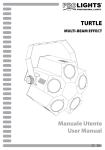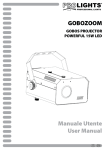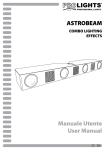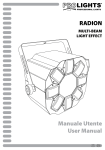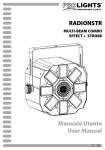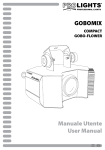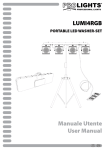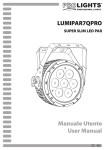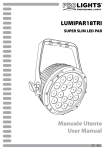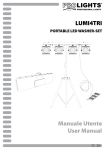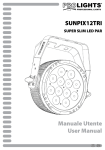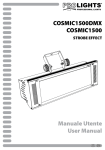Download Manuale Utente User Manual QUADMOON
Transcript
QUADMOON MULTI-BEAM EFFECT Manuale Utente User Manual IT EN Music & Lights S.r.l. si riserva ogni diritto di elaborazione in qualsiasi forma delle presenti istruzioni per l’uso. La riproduzione - anche parziale - per propri scopi commerciali è vietata. Al fine di migliorare la qualità dei prodotti, la Music&Lights S.r.l. si riserva la facoltà di modificare, in qualunque momento e senza preavviso, le specifiche menzionate nel presente manuale di istruzioni. Tutte le revisioni e gli aggiornamenti sono disponibili nella sezione 'Manuali' sul sito www.musiclights.it REV.001-09/12 QUADMOON INDICE Sicurezza Avvertenze generali Attenzioni e precauzioni per l’installazione Informazioni generali 4 4 5 1 Introduzione 1. 1 Descrizione 1. 2 Specifiche tecniche 1. 3 Elementi di comando e di collegamento 6 6 7 2 Installazione 2. 1 Montaggio 8 3 Funzioni e impostazioni 3. 1 Funzionamento 3. 2 Impostazione DIP-switch 3. 3 Modalità musicale 3. 4 Modalità DMX 3. 5 Collegamenti della linea DMX 3. 6 Costruzione del terminatore DMX 3. 7 Indirizzamento DMX 3. 8 Tabella canali DMX 9 9 9 9 10 10 11 12 4 Manutenzione 4. 1 Manutenzione e pulizia del sistema ottico 4. 2 Sostituzione fusibile 4. 3 Risoluzione dei problemi 14 14 15 Certificato di garanzia Contenuto dell'imballo: 3 • QUADMOON • Cavo di alimentazione • Manuale utente QUADMOON 4 ATTENZIONE! Prima di effettuare qualsiasi operazione con l’unità, leggere con attenzione questo manuale e conservarlo accuratamente per riferimenti futuri. Contiene informazioni importanti riguardo l’installazione, l’uso e la manutenzione dell’unità. SICUREZZA Avvertenze generali • I prodotti a cui questo manuale si riferisce sono conformi alle Direttive della Comunità Europea e pertanto recano la sigla . • Il dispositivo funziona con pericolosa tensione di rete 230V~. Non intervenire mai al suo interno al di fuori delle operazioni descritte nel presente manuale; esiste il pericolo di una scarica elettrica. • È obbligatorio effettuare il collegamento ad un impianto di alimentazione dotato di un’efficiente messa a terra (apparecchio di Classe I secondo norma EN 60598-1). Si raccomanda, inoltre, di proteggere le linee di alimentazione delle unità dai contatti indiretti e/o cortocircuiti verso massa tramite l’uso di interruttori differenziali opportunamente dimensionati. • Le operazioni di collegamento alla rete di distribuzione dell’energia elettrica devono essere effettuate da un installatore elettrico qualificato. Verificare che frequenza e tensione della rete corrispondono alla frequenza ed alla tensione per cui l’unità è predisposta, indicate sulla targhetta dei dati elettrici. • L’unità non per uso domestico, solo per uso professionale. • Evitare di utilizzare l’unità: - in luoghi soggetti a vibrazioni, o a possibili urti; - in luoghi a temperatura superiore ai 40°C. • Evitare che nell’unità penetrino liquidi infiammabili, acqua o oggetti metallici. • Non smontare e non apportare modifiche all’unità. • Tutti gli interventi devono essere sempre e solo effettuati da personale tecnico qualificato. Rivolgersi al più vicino centro di assistenza tecnica autorizzato. • Se si desidera eliminare il dispositivo definitivamente, consegnarlo per lo smaltimento ad un’istituzione locale per il riciclaggio. Attenzioni e precauzioni per l’installazione • Se il dispositivo dovesse trovarsi ad operare in condizioni differenti da quelle descritte nel presente manuale, potrebbero verificarsi dei danni; in tal caso la garanzia verrebbe a decadere. Inoltre, ogni altra operazione potrebbe provocare cortocircuiti, incendi, scosse elettriche, rotture etc. • Questo prodotto è solo per uso interno. Per prevenire il rischio di incendi o scosse elettriche, non esporre il prodotto alla pioggia o all’umidità. • Installare l’unità in un luogo ben ventilato. La distanza minima tra il dispositivo e le pareti circostanti deve essere superiore a 50 cm e non devono essere ostruite, in nessun caso, le aperture d’aerazione. • Non toccare il prodotto quando è in funzione perché potrebbe essere molto caldo. • Prima di iniziare qualsiasi operazione di manutenzione o pulizia sull’unità togliere la tensione dalla rete di alimentazione. • È assolutamente necessario proteggere l’unità per mezzo di una fune di sicurezza. Nell’eseguire qualsiasi intervento attenersi scrupolosamente a tutte le normative (in materia di sicurezza) vigenti nel paese di utilizzo. • Mantenere i materiali infiammabili ad una distanza di sicurezza dall’unità. • Non guardare direttamente il fascio luminoso. Tenere presente che i veloci cambi di luce possono provocare attacchi d’epilessia presso persone fotosensibili o epilettiche. • Non collegare l’unità a un dimmer pack. QUADMOON 5 INFORMAZIONI GENERALI Spedizioni e reclami Le merci sono vendute “franco nostra sede” e viaggiano sempre a rischio e pericolo del distributore/cliente. Eventuali avarie e danni dovranno essere contestati al vettore. Ogni reclamo per imballi manomessi dovrà essere inoltrato entro 8 giorni dal ricevimento della merce. Garanzie e resi Il prodotto è coperto da garanzia in base alle vigenti normative. Sul sito www.musiclights.it è possibile consultare il testo integrale delle “Condizioni Generali di Garanzia”. Si prega, dopo l’acquisto, di procedere alla registrazione del prodotto sul sito www.musiclights.it. In alternativa il prodotto può essere registrato compilando e inviando il modulo riportato alla fine del manuale. A tutti gli effetti la validità della garanzia è avallata unicamente dalla presentazione del certificato di garanzia. Music & Lights constata tramite verifica sui resi la difettosità dichiarata, correlata all’appropriato utilizzo, e l’effettiva validità della garanzia; provvede quindi alla riparazione dei prodotti, declinando tuttavia ogni obbligo di risarcimento per danni diretti o indiretti eventualmente derivanti dalla difettosità. 6 QUADMOON - 1 - INTRODUZIONE 1.1 DESCRIZIONE Effetto multiraggio composto di 4 proiettori moonflower a tecnologia LED RGBW. Le 4 lenti di proiezione offrono un ampio angolo di emissione, producendo centinaia di raggi multicolore in movimento e rotazione. 1.2 SPECIFICHE TECNICHE • Sorgente Luminosa: 228 RGBW LEDs (48 rossi, 72 verde, 72 blu, 36 bianchi) (57 LEDs per ogni singola lente) • Miscelazione colore: RGBW/FC per una gamma cromatica senza limiti • Tipologia di effetto: effetto multi-raggio ad ampia emissione, con fasci multicolore e rotanti • Durata media diodi LED: >50.000 ore • Angolo di proiezione: 70°, le 4 lenti producono centinaia di punti luce • Rotazione fasci controllabile in senso orario e antiorario • Pannello di controllo e interfaccia utente tramite display LED (4-caratteri) • Modalità Automatica: programmi automatici preimpostati con regolazione velocità • Modalità DMX: 6 canali di funzionamento per il controllo indipendente dei giochi di luce e colori • Modalità Master/Slave: per il controllo di più unità collegate in catena • Modalità Sound: attivazione musicale tramite microfono interno, controllo sensibilità • Connessioni: XLR-3p (segnale), presa VDE (alimentazione) • Alimentazione: AC 100/240V, 50/60Hz • Assorbimento medio: 20W • Output alimentazione per connessione di più unità in serie: fino a 37 proiettori a 230V • Peso: 4 kg • Dimensioni (LxAxP): 470x112x295mm QUADMOON 7 1.3 ELEMENTI DI COMANDO E DI COLLEGAMENTO 1 A 2 3 4 5 6 7 1 2 3 4 5 6 7 8 9 10 ON Zoom A 10 9 8 Fig.1 1. STAFFA DI MONTAGGIO 2. MANOPOLA DI FISSAGGIO per la staffa di montaggio 3. DMX IN (XLR a 3 poli): 1 = massa, 2 = DMX -, 3 = DMX 4. DMX OUT (XLR a 3 poli): 1= massa, 2 = DMX -, 3 = DMX + 5. DIP-SWITCH [1] - [10] per modalità modalità di funzionamento 6. REGOLATORE SENSIBILITÀ AUDIO nella modalità sound 7. POWER OUT output alimentazione per connessioni di più unità in serie. 8. POWER IN spina da pannello VDE per il collegamento ad una presa di rete (110-240V~/50-60Hz) tramite il cavo di rete in dotazione. Sopra la spina si trova il portafusibile. Sostituire un fusibile difettoso solo con uno dello stesso tipo. 9. MICROFONO per il comando tramite la musica 10. SAFETY EYE per l'aggancio al cavo di sicurezza QUADMOON 8 - 2 - INSTALLAZIONE 2.1 MONTAGGIO Il QUADMOON può essere collocato su un piano solido. Inoltre, grazie alle possibilità di fissaggio sulla doppia staffa (fig.2), l’unità può essere montata anche a testa in giù, su una traversa. Per il fissaggio occorrono dei supporti robusti per il montaggio. L’area di collocazione deve avere una stabilità sufficiente e supportare almeno 10 volte il peso dell’unità. Assicurarsi di rispettare tutte le avvertenze in materia di sicurezza. • Fissare il proiettore attraverso l’apposita staffa (1) ad una collocazione idonea. • È assolutamente necessario assicurare il proiettore contro la caduta utilizzando un cavo di sicurezza: in particolare collegare il cavo in un punto adatto in modo che la caduta del proiettore non possa superare i 20 cm. • Orientare il proiettore intervenendo, se necessario, sulla manopola della staffa di montaggio (2) 1 2 Fig.2 QUADMOON 9 - 3 - FUNZIONI E IMPOSTAZIONI 3.1 FUNZIONAMENTO Per accendere il QUADMOON, inserire la spina del cavo di alimentazione in una presa di rete (110-240VAC~ 50Hz). L’unità può essere comandata da un unità DMX di comando luce oppure svolgere autonomamente il suo programma. Per spegnere il QUADMOON, staccare la spina dalla presa di rete. Per maggiore comodità è consigliabile collegare l’unità con una presa comandata da un interruttore. 3.2 IMPOSTAZIONE DIP-SWITCH Il QUADMOON dispone di un pannello di controllo base costituito da un modulo DIP-switch (fig.3). Ciascuno dei singoli switch dispone di un numero (DIP switch [1] a [10]). Fig.3 3.3 MODALITÀ MUSICALE Se alla presa DMX INPUT non è presente alcun segnale di comando DMX, l’unità svolge il suo programma show autonomamente tramite il microfono integrato. • Per impostare la modalità musicale è necessario posizionare il DIP-switch [1-10] su “OFF” (fig.4) • Regolare la sensibilità del microfono integrato con la relativa manopola di regolazione. Fig.4 3.4 MODALITÀ DMX Per il funzionamento tramite l’unit di controllo DMX far riferimento alla tabella a pag.12, che riporta le funzioni e i relativi valori DMX. Come interfaccia DMX, l’unità possiede contatti XLR a 3 poli. • Per impostare la modalità DMX posizionare il DIP-switch [10] su “ON” • Attraverso i DIP-switch [1 - 9] è possibile selezionare i diversi indirizzi DMX. Fig.5 Modalità DMX 10 QUADMOON 3.5 COLLEGAMENTI DELLA LINEA DMX La connessione DMX è realizzata con connettori standard XLR. Utilizzare cavi schermati, 2 poli ritorti, con impedenza 120Ω e bassa capacità. Per il collegamento fare riferimento allo schema di connessione riportato di seguito: DMX - INPUT Spina XLR Pin1 : Massa - Schermo Pin2 : - Negativo Pin3 : + Positivo DMX - OUTPUT Presa XLR Fig.6 ATTENZIONE La parte schermata del cavo (calza) non deve mai essere collegata alla terra dell’impianto; ciò comporterebbe malfunzionamenti delle unità e dei controller. Per passaggi lunghi può essere necessario l’inserimento di un amplificatore DMX. In tal caso, è sconsigliato utilizzare nei collegamenti cavo bilanciato microfonico poiché non è in grado di trasmettere in modo affidabile i dati di controllo DMX. • Collegare l’uscita DMX del controller con l’ingresso DMX della prima unità; • Collegare, quindi, l’uscita DMX con l’ingresso DMX della successiva unità; l’uscita di quest’ultima con l’ingresso di quella successiva e via dicendo finchè tutte le unità sono collegate formando una catena. • Per installazioni in cui il cavo di segnale deve percorrere lunghe distanze è consigliato inserire sull’ultima unità una terminazione DMX. 3.6 COSTRUZIONE DEL TERMINATORE DMX La terminazione evita la probabilità che il segnale DMX 512, una volta raggiunta la fine della linea stessa venga riflesso indietro lungo il cavo, provocando, in certe condizioni e lunghezze, la sua sovrapposizione al segnale originale e la sua cancellazione. La terminazione deve essere effettuata, sull’ultima unità della catena, con connettori XLR a 3 pin, saldando una resistenza di 120Ω (minimo 1/4W) tra i terminali 2 e 3, così come indicato in figura. Esempio: connettore XLR a 3 pin Fig.7 QUADMOON 11 3.7 INDIRIZZAMENTO DMX Per poter comandandare il proiettore QUADMOON con un’unità di comando luce, occorre impostare l’indirizzo di start DMX per il primo canale DMX. Se, per esempio, sull’unità di comando è previsto l’indirizzo 33 per comandare la funzione del primo canale DMX, si deve impostare sul QUADMOON l’indirizzo di start 33. Le altre funzioni del pannello saranno assegnate automaticamente agli indirizzi successivi. Segue un esempio con indirizzo 33 di start: Numero canali DMX Indirizzo di start (esempio) Indirizzo DMX occupati Prossimo indirizzo di start possibile per unità n°1 Prossimo indirizzo di start possibile per unità n°2 Prossimo indirizzo di start possibile per unità n°3 6 33 33-38 39 45 51 Numero switch DIP-SWITCH 1 2 3 4 5 6 7 8 9 DMX VALUE 1 2 4 8 16 32 64 128 256 L’indirizzo di start viene impostato come numero binario per mezzo dei DIP-switch n° 1 - 9. Quindi, risulta dall’addizione dei valori dei DIP-switchs posizionati su “ON”. Esempi per gli indirizzi 1, 6 e 104: Numero switch 256 1 2 4 8 16 32 64 128 Indirizzo di start 1: switch n°1 su "ON" Valore 256 1 2 4 8 16 32 64 128 Indirizzo di start 6: switch n°2 e 3 su "ON" 256 1 2 4 8 16 32 64 128 Indirizzo di start 104: switch n°4, 6 e 7 su "ON" Il modo più semplice è quello di partire sempre dal massimo valore possibile aggiungendo i valori minori fino a raggiungere, come somma, l’indirizzo di start. QUADMOON 12 3.8 TABELLA CANALI DMX CH6 CH Function in CH6 mode MODULE 1-4 No function Group 1 of White Group 2 of White Group 3 of White Group 1 of Red Group 2 of Red Group 3 of Red Group 1 of Green Group 2 of Green Group 3 of Green Group 1 of Blue Group 2 of Blue Group 3 of Blue All White All Red All Green All Blue All Red & Green 1-4 All Red & Blue All Green & Blue All Red & Green & Blue All Red & White All Green & White All Blue & White Group 1 of Blue & all White Group 2 of Blue & all Red Group 3 of Blue & all Green Group 1 of Blue & group 3 of Red Group 2 of Blue & group 2 of Red Group 3 of Blue & group 1 of Red Group 1 of Green & group 3 of White Group 2 of Green & group 2 of White Group 3 of Green & group 1 of White Group 1 of Blue, group 3 of Green, group 1 of Red & group 3 of White Group 2 of Blue, group 2 of Green, group 2 of Red & group 2 of White Group 3 of Blue, group 1 of Green, group 3 of Red & group 1 of White All White & Red & Green & Blue STROBE 5 No function Slow - Fast Value 000 - 010 011 - 016 017 - 022 023 - 028 029 - 034 035 - 040 041 - 046 047 - 052 053 - 058 059 - 064 065 - 070 071 - 076 077 - 082 083 - 088 089 - 094 095 - 100 101 - 106 107 - 112 113 - 118 119 - 124 125 - 130 131 - 136 137 - 142 143 - 148 149 - 154 155 - 160 161 - 166 167 - 172 173 - 178 179 - 184 185 - 190 191 - 196 197 - 202 203 - 208 209 - 214 215 - 220 221 - 255 000 - 010 011 - 255 QUADMOON CH Function in CH6 mode 6 AUTO PROGRAM No function Program 1 Program 2 Program 3 Program 4 Program 5 Program 6 Program 7 Program 8 Auto Mode Sound Mode 13 Value 000 - 010 011 - 036 037 - 062 063 - 088 089 - 114 115 - 130 131 - 156 157 - 182 183 - 208 209 - 250 251 - 255 14 QUADMOON - 4 - MANUTENZIONE 4.1 MANUTENZIONE E PULIZIA DEL SISTEMA OTTICO Per mantenere prestazioni ottimali e ridurre al minimo l’usura, il dispositivo deve essere pulito frequentemente. L’utilizzo e l’ambiente sono fattori che contribuiscono a determinare la frequenza di pulizia. Come regola generale, il dispositivo deve essere pulito almeno due volte al mese. L’accumulo di polvere riduce la luminosità e può causare il surriscaldamento. Questo può portare a ridurre la vita della sorgente luminosa e accrescere usura meccanica. Assicurarsi di spegnere il dispositivo prima di effettuare la manutenzione. Staccare la spina di alimentazione. Utilizzare un compressore d’aria o una spazzola morbida per rimuovere la polvere raccolta sulle prese d’aria esterne e sui componenti interni. Pulire i vetri ad apparecchio freddo con una soluzione leggera di detergenti per vetri e un panno morbido. Applicare la soluzione al panno e trascinare lo sporco verso l’esterno della lente. Delicatamente lucidare le superfici del sistema ottico fino a che non siano privi di lanugine. La pulizia di lenti ottiche interne ed esterne e/o specchi deve essere eseguita periodicamente per ottenere al massima intensità luminosa: pulire le ottiche esterne almeno ogni 20 giorni; pulire le ottiche interne almeno ogni 30/60 giorni. Attenzione - Consigliamo che la pulizia interna sia eseguita da personale qualificato. 4.2 SOSTITUZIONE FUSIBILE 1. Assicurarsi di scollegare il cavo di alimentazione del proiettore prima di sostituire un fusibile bruciato con uno dello stesso tipo e valore. 2. Con un cacciavite, rimuovere il portafusibile dalla sua sede e il fusibile bruciato dal suo supporto; sostituire il fusibile con uno identico per tipologia e valore. 3. Inserire il portafusibile al suo posto e ricollegare l’alimentazione. Fusibile Fig.8 QUADMOON 15 4.3 RISOLUZIONE DEI PROBLEMI Anomalie Possibili cause Il proiettore non illumina • • • • • Bassa intensità di luce generale Il proiettore non è alimentato Il proiettore non risponde al DMX Controlli e rimedi • • • • • • • Mancanza di alimentazione di rete Dimmer impostato a 0 Tutti i colori impostati a 0 LED difettoso/i Scheda LED difettosa Lenti sporche Lente disallineata • • Verificare la presenza della tensione alimentazione Incrementare i valori del canale dimmer Incrementare i valori dei canali colori Sostituire scheda LED Sostituire scheda LED Pulire il dispositivo regolarmente Installare il gruppo ottico correttamente • • • Mancanza di alimentazione di rete Cavo di alimentazione danneggiato Alimentatore interno difettoso • • • Verificare la presenza della tensione alimentazione Controllare il cavo di alimentazione Sostituire l'alimentatore interno • Indirizzamento DMX errato • • • Cavo di segnale DMX difettoso Rimbalzo segnale DMX • • Controllare il pannello di controllo e l'indirizzamento delle unità Controllare il cavo di segnale DMX Installare una terminazione DMX come suggerito Rivolgersi a un centro di assistenza tecnico autorizzato in caso di problema non riportato in tabella o che non possono essere risolti mediante la procedura riportata in tabella. All rights reserved by Music & Lights S.r.l. No part of this instruction manual may be reproduced in any form or by any means for any commercial use. In order to improve the quality of products, Music&Lights S.r.l. reserves the right to modify the characteristics stated in this instruction manual at any time and without prior notice. All revisions and updates are available in the ‘manuals’ section on site www.musiclights.it QUADMOON TABLE OF CONTENTS Safety General instructions Warnings and installation precautions General information 2 2 3 1 Introduction 1. 1 Description 1. 2 Technical specifications 1. 3 Operating elements and connections 4 4 5 2 Installation 2. 1 Mounting 6 3 Functions and settings 3. 1 Operation 3. 2 Setting of DIP-switch 3. 3 Sound active 3. 4 DMX mode 3. 5 Connection of the DMX line 3. 6 Construction of the DMX termination 3. 7 DMX addressing 3. 8 DMX control 7 7 7 7 8 8 9 10 4 Maintenance 4. 1 Maintenance and cleaning the unit 4. 2 Fuse replacement 4. 3 Trouble shooting 12 12 13 Warranty Packing content 1 • QUADMOON • Power cord • User manual QUADMOON 2 WARNING! Before carrying out any operations with the unit, carefully read this instruction manual and keep it with cure for future reference. It contains important information about the installation, usage and maintenance of the unit. SAFETY General instruction • The products referred to in this manual conform to the European Community Directives and are therefore marked with . • The unit is supplied with hazardous network voltage (230V~). Leave servicing to skilled personnel only. Never make any modifications on the unit not described in this instruction manual, otherwise you will risk an electric shock. • Connection must be made to a power supply system fitted with efficient earthing (Class I appliance according to standard EN 60598-1). It is, moreover, recommended to protect the supply lines of the units from indirect contact and/or shorting to earth by using appropriately sized residual current devices. • The connection to the main network of electric distribution must be carried out by a qualified electrical installer. Check that the main frequency and voltage correspond to those for which the unit is designed as given on the electrical data label. • This unit is not for home use, only professional applications. • Never use the fixture under the following conditions: - in places subject to vibrations or bumps; - in places with a temperature of over 40°C. • Make certain that no inflammable liquids, water or metal objects enter the fixture. • Do not dismantle or modify the fixture. • All work must always be carried out by qualified technical personnel. Contact the nearest sales point for an inspection or contact the manufacturer directly. • If the unit is to be put out of operation definitively, take it to a local recycling plant for a disposal which is not harmful to the environment. Warnings and installation precautions • If this device will be operated in any way different to the one described in this manual, it may suffer damage and the guarantee becomes void. Furthermore, any other operation may lead to dangers like short circuit, burns, electric shock, etc. • Before starting any maintenance work or cleaning the projector, cut off power from the main supply. • Always additionally secure the projector with the safety rope. When carrying out any work, always comply scrupulously with all the regulations (particularly regarding safety) currently in force in the country in which the fixture’s being used. • Install the fixture in a well ventilated place. • Keep any inflammable material at a safe distance from the fixture. • Shields, lenses or ultraviolet screens shall be changed if they have become damaged to such an extent that their effectiveness is impaired. • The lamp (LED) shall be changed if it has become damaged or thermally deformed. • Never look directly at the light beam. Please note that fast changes in lighting, e. g. flashing light, may trigger epileptic seizures in photosensitive persons or persons with epilepsy. • Don’t connect the device to a dimmer pack. • Never expose the lens to direct sunlight, even for a short period. This may damage the light effect or even cause fire. QUADMOON 3 GENERAL INFORMATION Shipments and claims The goods are sold “ex works” and always travel at the risk and danger of the distributor. Eventual damage will have to be claimed to the freight forwarder. Any claim for broken packs will have to be forwarded within 8 days from the reception of the goods. Warranty and returns The guarantee covers the fixture in compliance with existing regulations. You can find the full version of the “General Guarantee Conditions” on our web site www.musiclights.it. Please remember to register the piece of equipment soon after you purchase it, logging on www.musiclights.it. The product can be also registered filling in and sending the form available on your guarantee certificate. For all purposes, the validity of the guarantee is endorsed solely on presentation of the guarantee certificate. Music & Lights will verify the validity of the claim through examination of the defect in relation to proper use and the actual validity of the guarantee. Music & Lights will eventually provide replacement or repair of the products declining, however, any obligation of compensation for direct or indirect damage resulting from faultiness. 4 QUADMOON - 1 - INTRODUCTION 1.1 DESCRIPTION Multi-beam effect based on 4 moonflower projectors with RGBW LED source. The 4 pods offer a wide coverage field, producing hundreds of moving, coloured and rotating beams. 1.2 TECHNICAL SPECIFICATIONS • Light source: 228 RGBW LEDs (48 red, 72 green, 72 blue, 36 white), 57 in each pods • Colour mixing: RGBW/FC for a limitless colour range • Effect type: Multi-beam effect with high-coverage ratio, razor, coloured and rotating beams • LED average life span: >50’000 hours • Beam angle: 70°, the 4 pods create hundred of light-beams • Controllable CW and CCW rotation of beams through DMX • Control panel and user interface through 4 char LED display • Auto mode: built-in programs with speed execution adjustment • DMX mode: 6 channels for remote controlling of colours and show sessions • Master/Slave mode: for synchronized operation of more units linked in a chain • Sound mode: sound activation through built-in microphone with sensitivity adjustment • Connections: XLR-3p (signal), VDE socket (power) • Hanging system: adjustable aluminium bracket • Power supply: AC 100/240V, 50/60Hz • Power consumption: 20W • Power output to link more units in a chain: up to 37 fixtures at 230V • Weight: 4 kg • Dimensions (WxHxD): 470x112x295mm QUADMOON 5 1.3 OPERATING ELEMENTS AND CONNECTIONS 1 A 2 3 4 5 6 7 1 2 3 4 5 6 7 8 9 10 ON Zoom A 10 9 8 Fig.1 1. MOUNTING BRACKET 2. LOCKING KNOB for the mounting bracket. 3. DMX IN (3-pole XLR): 1 = ground, 2 = DMX -, 3 = DMX 4. DMX OUT (3-pole XLR): 1= ground, 2 = DMX -, 3 = DMX + 5. DIP-SWITCH [1] - [10] to select the different functions 6. CONTROL SENSITIVITY for the sensitivity of response in case of music control via the internal microphone. 7. POWER OUT 8. POWER IN mains plug for connection to a socket (100-240V 50/60Hz) via the supplied mains cable. The support for the mains fuse is located near the mains plug. Only replace a blown fuse by one of the same type. 9. MICROPHONE to control the show by the external audio signal. 10. SAFETY EYE to attach safety cable. QUADMOON 6 - 2 - INSTALLATION 2.1 MOUNTING QUADMOON may be set up on a solid and even surface. The unit can also be mounted upside down to a cross arm. For fixing, stable mounting clips are required. The mounting place must be of sufficient stability and be able to support a weight of 10 times of the unit’s weight. When carrying out any installation, always comply scrupulously with all the regulations (particularly regarding safety) currently in force in the country in which the fixture’s being used. • Install the projector at a suitable location by means of the mounting bracket (1). • Always additionally secure the projector with the safety rope from falling down. For this purpose, fasten the safety rope at a suitable position so that the maximum fall of the projector will be 20 cm. • Adjust the projector and use the knob (2) to slightly release or tighten the locking mechanism of the bracket if is necessary. 1 2 Fig.2 QUADMOON 7 - 3 - FUNCTIONS AND SETTINGS 3.1 OPERATION Connect the supplied main cable to a socket (100-240 VAC-50/60 Hz). Then the unit is ready for operation and can be operated via a DMX controller or it independently performs its show program in succession. To switch off, disconnect the mains plug from the socket. For a more convenient operation it is recommended to connect the unit to a socket which can be switched on and off via a light switch. 3.2 SETTING OF DIP-SWITCH The QUADMOON has a basic control panel consists of a DIP-switch (fig.3) Each individual switch has a number (DIP-switch [1] to [10]). Fig.3 3.3 SOUND ACTIVE If no DMX control signal is present at the jack DMX INPUT, and the unit independently runs through its show programme via built-in microphone. • To set the automatic mode is necessary to position the DIP-switch [1-10] to “OFF” • Use the microphone sensitivity adjustment knob to adjust the fixture to react to the beat of the music. Fig.4 3.4 DMX MODE To operate the unit via DMX control to the table on pag.10, which shows the functions and values DMX. As DMX interface, the unit has 3 poles XLR contacts. • To set the DMX mode position the DIP-switch [10] to “ON”. • Through DIP-switch [1 - 9] you can select different DMX addresss. Fig.5 DMX mode 8 QUADMOON 3.5 CONNECTION OF THE DMX LINE DMX connection employs standard XLR connectors. Use shielded pair-twisted cables with 120Ω impedance and low capacity. The following diagram shows the connection mode: DMX - INPUT XLR plug Pin1 : GND - Shield Pin2 : - Negative Pin3 : + Positive DMX - OUTPUT XLR socket Fig.7 ATTENTION The screened parts of the cable (sleeve) must never be connected to the system’s earth, as this would cause faulty fixture and controller operation. Over long runs can be necessary to insert a DMX level matching amplifier. For those connections the use of balanced microphone cable is not recommended because it cannot transmit control DMX data reliably. • Connect the controller DMX input to the DMX output of the first unit. • Connect the DMX output to the DMX input of the following unit. Connect again the output to the input of the following unit until all the units are connected in chain. • When the signal cable has to run longer distance is recommended to insert a DMX termination on the last unit. 3.6 CONSTRUCTION OF THE DMX TERMINATION The termination avoids the risk of DMX 512 signals being reflected back along the cable when they reaches the end of the line: under certain conditions and with certain cable lengths, this could cause them to cancel the original signals. The termination is prepared by soldering a 120Ω 1/4 W resistor between pins 2 and 3 of the 5-pin male XLR connector, as shown in figure.una resistenza di 120Ω (minimo 1/4W) tra i terminali 2 e 3, così come indicato in figura. Esempio: connettore XLR a 3 pin Fig.8 QUADMOON 9 3.7 DMX ADDRESSING To able to operate the QUADMOON with a light controller, adjust the DMX start address for the first a DMX channel. If e. g. address 33 on the controller is provided for controlling the function of the first DMX channel, adjust the start address 33 on the QUADMOON. The other functions of the light effect panel are then automatically assigned to the following addresses. An example with the start address 33 is shown below: Number of DMX channels Start address (example) DMX Address occupied Next possible start address for unit No. 1 Next possible start address for unit No. 2 Next possible start address for unit No. 3 6 33 33-38 39 45 51 Switch number DIP-SWITCH 1 2 3 4 5 6 7 8 9 DMX VALUE 1 2 4 8 16 32 64 128 256 The address is set to start as a binary number by means of DIP-switch n° 1 - 9. Thus, it appears the addition values of DIP-switches positioned to ON. Examples with the start addresses 1, 6 and 104: Switch number 256 1 2 4 8 16 32 64 128 Start address 1: switch n° 1 set to ON Value 256 1 2 4 8 16 32 64 128 Start address 6: switch n° 2 e 3 set to ON 256 1 2 4 8 16 32 64 128 Start address 104: switch n° 4, 6 e 7 set to ON The easiest way is to start from the highest possible place value and to add the smaller values until the start address will result 10 QUADMOON 3.8 DMX CONTROL CH6 CH Function in CH6 mode MODULE 1-4 No function Group 1 of White Group 2 of White Group 3 of White Group 1 of Red Group 2 of Red Group 3 of Red Group 1 of Green Group 2 of Green Group 3 of Green Group 1 of Blue Group 2 of Blue Group 3 of Blue All White All Red All Green All Blue All Red & Green 1-4 All Red & Blue All Green & Blue All Red & Green & Blue All Red & White All Green & White All Blue & White Group 1 of Blue & all White Group 2 of Blue & all Red Group 3 of Blue & all Green Group 1 of Blue & group 3 of Red Group 2 of Blue & group 2 of Red Group 3 of Blue & group 1 of Red Group 1 of Green & group 3 of White Group 2 of Green & group 2 of White Group 3 of Green & group 1 of White Group 1 of Blue, group 3 of Green, group 1 of Red & group 3 of White Group 2 of Blue, group 2 of Green, group 2 of Red & group 2 of White Group 3 of Blue, group 1 of Green, group 3 of Red & group 1 of White All White & Red & Green & Blue STROBE 5 No function Slow - Fast Value 000 - 010 011 - 016 017 - 022 023 - 028 029 - 034 035 - 040 041 - 046 047 - 052 053 - 058 059 - 064 065 - 070 071 - 076 077 - 082 083 - 088 089 - 094 095 - 100 101 - 106 107 - 112 113 - 118 119 - 124 125 - 130 131 - 136 137 - 142 143 - 148 149 - 154 155 - 160 161 - 166 167 - 172 173 - 178 179 - 184 185 - 190 191 - 196 197 - 202 203 - 208 209 - 214 215 - 220 221 - 255 000 - 010 011 - 255 QUADMOON CH Function in CH6 mode 6 AUTO PROGRAM No function Program 1 Program 2 Program 3 Program 4 Program 5 Program 6 Program 7 Program 8 Auto Mode Sound Mode 11 Value 000 - 010 011 - 036 037 - 062 063 - 088 089 - 114 115 - 130 131 - 156 157 - 182 183 - 208 209 - 250 251 - 255 12 QUADMOON - 4 - MAINTENANCE 4.1 MAINTENANCE AND CLEANING THE UNIT To maintain optimum performance and minimize wear fixtures should be cleaned frequently. Usage and environment are contributing factors in determining frequency. As a general rule, fixtures should be cleaned at least twice a month. Dust build up reduces light output performance and can cause overheating. This can lead to reduced lamp life and increased mechanical wear. Be sure to power off fixture before conducting maintenance. Unplug fixture from power. Use a vacuum or air compressor and a soft brush to remove dust collected on external vents and internal components. Clean all glass when the fixture is cold with a mild solution of glass cleaner or detergent liquid and a soft lint free cotton cloth or lens tissue. Apply solution to the cloth or tissue and drag dirt and grime to the outside of the lens. Gently polish optical surfaces until they are free of haze and lint. The cleaning of internal and external optical lenses and/or mirrors must be carried out periodically to optimize light output. Clean the external optics at least every 20 days. Clean the internal optics at least every 30/60 days. Warning: we strongly recommend internal cleaning to be carried out by qualified personnel! 4.2 FUSE REPLACEMENT 1. Remove the safety cap by a screwdriver 2. Replace the blown fuse with a fuse of the exact same type and rating 3. Install the safety cap, and reconnect power. Fuse Fig.8 QUADMOON 13 4.3 TROUBLESHOOTING Problems Possible causes Checks and remedies Fixture does not light up • • • • • No mains supply Dimmer fader set to 0 All color faders set to 0 Faulty LED Faulty LED board • • • • • Check the power supply voltage Increase the value of the dimmer channels Increase the value of the color channels Replace the LED board Replace the LED board General low light intensity • • Dirty lens assembly Misaligned lens assembly • • Clean the fixture regularly Install lens assembly properly Fixture does not power up • • • No power Loose or damaged power cord Faulty internal power supply • • • Check for power on power outlet Check power cord Replace internal power supply Fixture does not respond to DMX • • • Wrong DMX addressing Damaged DMX cables Bouncing signals • • • Check control panel and unit addressing Check DMX cables Install terminator as suggested Contact an authorized service center in case of technical problems or not reported in the table can not be resolved by the procedure given in the table. • Si prega, dopo l’acquisto, di procedere alla registrazione del prodotto sul sito www.musiclights.it. In alternativa il prodotto può essere registrato compilando e inviando il modulo riportato sul retro. • Sono esclusi i guasti causati da imperizia e da uso non appropriato dell’apparecchio. • La garanzia non ha più alcun effetto qualora l’apparecchio sia stato manomesso. • La garanzia non prevede la sostituzione dell’apparecchio. • Sono escluse dalla garanzia le parti esterne, le lampade, le manopole, gli interruttori e le parti asportabili. • Le spese di trasporto e i rischi conseguenti sono a carico del possessore dell’apparecchio. • A tutti gli effetti la validità della garanzia è avallata unicamente dalla presentazione del certificato di garanzia. Estratto dalle Condizioni Generali di Garanzia Il prodotto è coperto da garanzia in base alle vigenti normative. Sul sito www.musiclights.it è possibile consultare il testo integrale delle “Condizioni Generali di Garanzia”. • Please remember to register the piece of equipment soon after you purchase it, logging on www.musiclights.it. The product can be also registered filling in and sending the form available on your guarantee certificate. • Defects caused by inexperience and incorrect handling of the equipment are excluded. • The guarantee will no longer be effective if the equipment has been tampered. • The guarantee makes no provision for the replacement of the equipment. • External parts, lamps, handles, switches and removable parts are not included in the guarantee. • Transport costs and subsequent risks are responsibility of the owner of the equipment. • For all purposes, the validity of the guarantee is endorsed solely on presentation of the guarantee certificate. Abstract General Guarantee Conditions The guarantee covers the unit in compliance with existing regulations. You can find the full version of the “General Guarantee Conditions” on our web site www.musiclights.it. CERTIFICATO DI GARANZIA GUARANTEE CERTIFICATE " Place Stamp Here Affrancare Spett.le Music&Lights S.r.l. Via Appia Km 136.200 04020 Itri (LT) Italy " " SURNAME / COGNOME Purchased by / Acquistato da SERIAL N° / SERIE N° MODEL / MODELLO SURNAME / COGNOME Purchased by / Acquistato da SERIAL N° / SERIE N° MODEL / MODELLO CITY / CITTà ADDRESS / VIA NAME / NOME N. NAME / NOME ADDRESS / VIA CITY / CITTA’ Dealer’s stamp and signature Timbro e firma del Rivenditore Dealer’s stamp and signature ZIP CODE / C.A.P. Timbro e firma del Rivenditore Purchasing date Data acquisto PROV. Purchasing date Data acquisto FORM TO BE FILLED IN AND KEPT / CEDOLA DA COMPILARE E CONSERVARE ZIP CODE / C.A.P. FORM TO BE FILLED IN AND MAILED / CEDOLA DA COMPILARE E SPEDIRE N. PROV. PROLIGHTS is a brand of Music & Lights S.r.l .company. ©2012 Music & Lights S.r.l. entertainment technologies Via Appia km 136,200 - 04020 Itri (LT) ITALY ISO 9001:2008 tel. +39 0771 72190 fax +39 0771 721955 Certified Company www.musiclights.it [email protected] PROLIGHTS è un brand di proprietà della Music & Lights S.r.l. Music & Lights S.r.l.




































